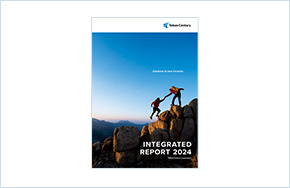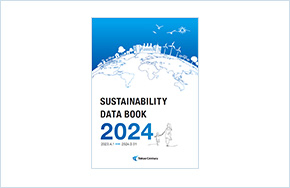Promoting the Active Participation of Diverse Human Resources
- Promoting Women’s Active Participation
- Informational Tables Concerning Women’s Active Participation
- Promotion of Women to Officer and Managerial Positions
- Promoting Active Participation of Global Human Resources
- Promoting Employment of Persons with Disabilities
Promoting Women’s Active Participation
Based on the Act of Promotion of Women’s Participation and Advancement in the Workplace, Tokyo Century promotes the success of women and has drawn up an action plan which enables each and every employee to work flexibly and in a diverse number of ways.
Action Plan for the Promotion of Women’s Active Participation
Plan Period
April 1, 2023 – March 31, 2028
Quantitative Targets
- Maintain the percentage of women in new-graduate hires to at least 40%
- Aim to increase the percentage of women in managerial positions to at least 30% by 2030
- Maintain the percentage of childcare leave acquisition in men to 100%
- Maintain the percentage of annual paid leave acquisition to at least 70%
Informational Tables Concerning Women’s Active Participation (Tokyo Century Only)
Ratio of women in employed workers
Scrollable horizontally
| FY2022 | FY2023 | FY2024 | |
|---|---|---|---|
| Regular employees | 29.5% | 25.7% | 38.6% |
| Administrative employees |
|
100.0% | 100.0% |
| Contractors | 0.0% | 41.7% | 0.0% |
| Total | 29.2% | 35.3% | 42.6% |
*Includes mid-career recruits
Average years of continuous employment by gender
Scrollable horizontally
| FY2022 | FY2023 | FY2024 | ||
|---|---|---|---|---|
| Women | Regular employees | 9.8 year | 9.3 year | 9.1 year |
| Administrative employees | 20.6 year | 21.1 year | 21.5 year | |
| Total | 16.7 year | 16.9 year | 16.8 year | |
| Men | Regular employees | 16.9 year | 17.3 year | 16.5 year |
| Administrative employees |
|
|
|
|
| Total | 16.9 year | 17.3 year | 16.5 year | |
*As of March 31 of each fiscal year
Ratio of women in managerial position
Scrollable horizontally
| FY2022 | FY2023 | FY2024 | |
|---|---|---|---|
| Women | 57 | 63 | 73 |
| Total men and women | 482 | 525 | 534 |
| Ratio | 11.8% | 12.0% | 13.7% |
*As of March 31 of each fiscal year
Average overtime hours per month
Scrollable horizontally
| FY2022 | FY2023 | FY2024 | |
|---|---|---|---|
| Regular employees | 17.2 hours | 16.8 hours | 16.0 hours |
| Administrative employees | 2.5 hours | 2.6 hours | 2.5 hours |
| Total | 11.8 hours | 11.6 hours | 11.3 hours |
*Labour outside legally designated hours
Ratio of successful job applicants by gender
Scrollable horizontally
| FY2022 | FY2023 | FY2024 | ||
|---|---|---|---|---|
| Women | Regular employees | 21.8 × | 26.9 × | 14.1 × |
| Administrative employees |
|
17.6 × | 13.0 × | |
| Contractors |
|
1.2 × |
|
|
| Total | 21.8 × | 20.7 × | 14.0 × | |
| Men | Regular employees | 18.6 × | 20.1 × | 20.6 × |
| Administrative employees |
|
|
|
|
| Contractors | 17.0 × | 1.0 × | 1.0 × | |
| Total | 18.6 × | 17.3 × | 20.1 × | |
*Includes mid-career recruits
Ratio of men to women in hiring
Scrollable horizontally
| FY2022 | FY2023 | FY2024 | |
|---|---|---|---|
| Regular employees | 1.2 | 1.3 | 0.7 |
| Administrative employees |
|
|
|
| Contractors |
|
1.2 |
|
| Total | 1.2 | 1.2 | 0.7 |
*Includes mid-career recruits
Ratio of women in labourers
Scrollable horizontally
| FY2022 | FY2023 | FY2024 | |
|---|---|---|---|
| Regular employees | 14.6% | 14.7% | 16.4% |
| Administrative employees | 100.0% | 100.0% | 100.0% |
| Contractors | 31.3% | 34.2% | 23.1% |
| Temporary staff | 90.5% | 92.7% | 93.1% |
| Total | 32.0% | 32.7% | 33.5% |
- *As of March 31 of each fiscal year
- *Consolidated base as of March 31, 2025 : 36.6% (Contractors and temporary staff are not included)
Ratio of continuous employment after ten year by gender
Scrollable horizontally
| FY2022 (New employees between FY 2011 and 2013) |
FY2023 (New employees between FY 2012 and 2014) |
FY2024 (New employees between FY 2013 and 2015) |
||
|---|---|---|---|---|
| Women | Regular employees | 60.0% | 66.7% | 75.0% |
| Administrative employees | 66.7% |
|
|
|
| Total | 61.5% | 66.7% | 75.0% | |
| Men | Regular employees | 65.4% | 56.0% | 44.4% |
| Administrative employees |
|
|
|
|
| Total | 65.4% | 56.0% | 44.4% | |
Rates of childcare leave acquisition by gender
Scrollable horizontally
| FY2022 | FY2023 | FY2024 | |
|---|---|---|---|
| Women | 114.3% | 85.7% | 83.3% |
| Men | 100.0% | 100.0% | 100.0% |
*Percentage of eligible employees who have taken long-term and short-term leave for childcare
Annual paid leave acquisition rates (usage rates)
Scrollable horizontally
| FY2022 | FY2023 | FY2024 | |
|---|---|---|---|
| Regular employees | 75.4% | 79.6% | 80.5% |
| Administrative employees | 88.1% | 85.4% | 86.1% |
| Contractors | 103.0% | 85.6% | 87.3% |
| Total | 78.8%(14.8 days) | 81.1%(15.2 days) | 81.2%(15.1 days) |
*Figures in brackets are average annual paid leave taken
Ratio of women in assistant managers or equivalent
Scrollable horizontally
| FY2022 | FY2023 | FY2024 | |
|---|---|---|---|
| Women | 119 | 133 | 143 |
| Total men and women | 240 | 257 | 268 |
| Ratio | 49.6% | 51.8% | 53.4% |
*As of March 31 of each fiscal year
Ratio of women officers
Scrollable horizontally
| FY2022 | FY2023 | FY2024 | |
|---|---|---|---|
| Women | 2 | 2 | 3 |
| Total men and women | 38 | 36 | 36 |
| Ratio | 5.3% | 5.6% | 8.3% |
- *As of March 31 of each fiscal year
- *Officers (including part time) = Directors, auditors, and executive officers
Occupational category or employment type change data by gender
Scrollable horizontally
| FY2022 | FY2023 | FY2024 | ||
|---|---|---|---|---|
| Occupational category change | Regular employee (Assigned to any region) → Regular employee (Metropolitan area only) |
|
|
|
| Regular employee (Metropolitan area only) → Regular employee (Assigned to any region) | 1 (Women) |
|
2 (Women) | |
| Regular employee (Assigned to any region) → Administrative employee |
|
|
|
|
| Regular employee (Metropolitan area only) → Administrative employee |
|
|
|
|
| Employment type change | Temporary staff → Administrative |
|
|
|
| Total | 1 |
|
2 | |
Re-employment and mid-career employment data by gender
Scrollable horizontally
| FY2022 | FY2023 | FY2024 | |
|---|---|---|---|
| Women | 10 | 10 | 11 |
| Men | 41 | 40 | 38 |
| Total | 51 | 50 | 49 |
*The Action Plan for the Promotion of Women’s Active Participation and Informational Tables Concerning Women’s Active Participation are also disclosed on the Ministry of Health, Labour and Welfare’s database of companies which promote women’s Participation and Advancement in the Workplace (Japanese only)
Promotion of Women to Officer and Managerial Positions
Tokyo Century established its Action Plan on the Promotion of Women to Officer and Managerial Positions* in October 2014 in order to steadily increase its number of female officers and managers through the active employment, training, and promotion of highly motivated and talented women.
Action Plan on the Promotion of Women to Officer and Managerial Positions
As a highly specialized and unique financial services company, Tokyo Century will work alongside customers in pursuit of their growth and further expand its business domains and drive global development.
To this end, we believe it essential to recruit, develop, and promote diverse talents, including women and foreign people, enabling each and every employee to maximize and demonstrate their abilities and individuality.
We aim to maintain the ratio of women among new-graduate hires at 40% or higher and increase the ratio of women among managers to 30% or higher by 2030. We will steadily increase the number of female executives and managers by actively promoting motivated and talented women (As of July 1, 2025, there are 3 women directors and 78 women managers [14.6%]). Furthermore, we will continuously work on reforming our workplace culture, supporting career development and ability improvement, enhancing and promoting systems for work-life balance, in order to create a workplace where each employee can work comfortably through every stage of life.
Number and ratio of women in managerial positions
Scrollable horizontally
| March 31, 2022 | March 31, 2023 | March 31, 2024 | March 31, 2025 | July 1, 2025 | |
|---|---|---|---|---|---|
| Number | 45 | 57 | 63 | 73 | 78 |
| Ratio | 9.7% | 11.8% | 12.0% | 13.7% | 14.6% |
Promoting Active Participation of Global Human Resources
Tokyo Century’s overseas network has been expanded to more than 30 countries and regions around the world through an alliance strategy in collaboration with local blue-chip companies overseas. Developing global human resources is essential for our continued growth.
Tokyo Century proactively continues to hire non-Japanese employees in Japan with the aim of developing and appointing diverse human resources who thrive around the globe.
In addition, Tokyo Century is working to develop human resources who can play an active role on the global stage in the future by establishing an international course for new graduates and actively promoting the overseas trainee system and overseas assignment for young employees.
And check out a roundtable discussion with employees who have worked in Asian countries in the Tokyo Century News article entitled “Realities of Working as an Expatriate: Four Young Employees Share Their Overseas Experience.”
Promoting Employment of Persons with Disabilities
Tokyo Century seeks talented individuals from an extensive array of backgrounds and strives to provide a place where highly motivated people can flourish. As part of this initiative, Tokyo Century actively employs persons with disabilities and fulfills the standards for the number of those employed as stipulated in the Act for the Promotion of Employment of Persons with Disabilities (Employment rate of persons with disabilities as of June 1, 2025: 2.83%).
To further promote the employment of people with disabilities, in April 2019 Tokyo Century opened the TC Work Happiness Farm in Funabashi, Chiba, hiring individuals with intellectual and psychiatric disabilities. We then expanded the farm in February 2021 and June 2023 to enhance this initiative.
TC Work Happiness Farm provides a secure, fulfilling, and long-term workplace for persons with disabilities. We grow vegetables in a farm house designed with safety and cleanliness as our motto, and donate the harvested vegetables to food bank Second Harvest Japan as part of the company’s CSR activities.
Second Harvest Japan (2HJ) was established in March 2002 as Japan’s first food bank. A food bank is a charitable organization that distributes food to those who are in need to avoid hunger. 2HJ redistributes a variety of food donated from food manufacturers, retailers, farmers and individuals that are unexpired and safe for consumption before disposing, to welfare agencies, orphanages, women shelters, people without homes, and others in need. Furthermore, 2HJ performs various relief activities to respond to the needs in the regions hit by the Great East Japan Earthquake, the 2024 Noto Peninsula Earthquake, and others.


